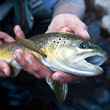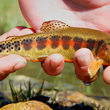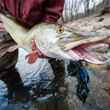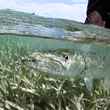The distant sounds of clanking metal and the crunching of gravel under truck tires alerted us that someone was coming down the forest road. We glanced up from the task of packing our camping gear and fly rods into our canoe and kayak as a logging truck barreled out of the tree line, coming to a screeching halt in the middle of the bridge that spanned the small river. A cloud of dust billowed out from behind the truck, washing over the cab and softly settling around us. The door opened with a loud and piercing squeak as a forester climbed out of the cab. He glanced down from the bridge to the river below. There was a look of surprise on his face as he noticed us for the first time.
“Sorry for the dust y’all,” he said, in his Oklahoma accent. “I didn’t see you down there.” He bent over to examine the tires on his truck. “Damn.” he said, “the road is real bad back there.” He nodded his head in the direction he had come, and then began walking around the vehicle, inspecting each tire.
“We came in the other way,” Nick called back from the riverbank, pointing in the opposite direction.
“Okay,” the forester said, “y’all should go back the way you came in. The road is too rough where I just come from. I don’t think your car will make it.”
We thanked him and he waved goodbye as he climbed into his truck and took off down the road. Once again, a cloud of dust picked up behind the vehicle and immediately gave chase. Although the truck was lost from view, the winding course of the forest road could still be traced by the billowing dirt rising above the treeline. The long continuous column rose through the air, marking the truck’s progress as it climbed out of the river valley.
When all was quiet again, the three of us looked at each other and smiled. If the washed-out forest roads leading to this river were any indication of what to expect, then we could assume two days of secluded adventure awaited us. We looked forward to exploring this beautiful and pristine waterway in southeastern Oklahoma, and to target the region’s native, stream-dwelling bass.
Visions of spirited smallmouth bass making acrobatic leaps and heart-pounding runs played in our minds while we stuffed our sleeping bags into waterproof bags and then lashed them down in the hulls of our paddlecraft. This rock-filled river looked like prime smallie habitat. Schools of baitfish basked in the shallows and dragonflies zipped through the air. Longear and green sunfish watched us with warranted suspicion from their refuge of aquatic grasses.
The thick leaves overhead cast dappled shadows that pranced across the hulls of our canoe and kayak. Gusts of summer air came blowing through the river valley making the leaves quake upon the trees, mimicking our excited anticipation for that final shove from the riverbank and the first pull of the paddle through the clear water.
Around this same time, many miles away from that Oklahoma river, three research biologists specializing in fish genetics awaited the publication of their latest scientific paper. The paper was titled, “Phylogenomics and species delimitation of the economically important Black Basses (Micropterus).” The paper made several groundbreaking claims about the genetic makeup of black bass species across the United States, including the populations of smallmouth bass in eastern Oklahoma. And the authors, Daemin Kim, Andrew T. Taylor, and Thomas J. Near, had just finished studying the very same fish we were after.
The article, originally appearing in Scientific Reports, claims there are nineteen different species of black bass. Fourteen of these species are currently described and well documented, but there are still five species which remain undescribed by biologists.
According to the authors, three of the five undescribed species exist in the rivers near the Oklahoma and Arkansas border. Originally, these fish were thought to be the same smallmouth bass that are found throughout the northern Mississippi River basin and across the northeast. The Linnean name for this northern variety of smallmouth bass being Micropterus dolomieu. However, according to Kim, Taylor, and Near, the three undescribed bass species native to the rivers of eastern Oklahoma and western Arkansas have a unique genetic makeup that sets them apart from the northern variety of smallmouth. What’s more, the genetic makeup of these three types of black bass are different from one another, making each one unique.
The authors claim that the three unique lineages of bass found in eastern Oklahoma and western Arkansas should be separated into their own distinct species. They refer to them as the Neosho Bass, the Ouachita Bass, and the Little River Bass. Each lineage of fish bears the name of the watersheds where they live. As it turns out, the Little River Bass is the kind we were pursuing.
When we finally kicked off the bank and started downstream, it was around noon. We had hardly made it beyond the first bend when we found ourselves tied up with a bass, the first one of the trip. It was an average specimen, a good fish to begin the trip with. When it took the fly, it did so in a vicious and sudden manner. Exactly what we had hoped for.

After landing the fish, we held it in the water, examining the colors of its mottled flanks, rich colors of tan and dark olive. Thick black lines radiated back from the edges of the eye, extending over the gill plate, like fearsome warpaint. That camouflaged face paint would be the stuff of nightmares if you were unlucky enough to be a longear sunfish in this river.
When the fish was released, it swam for the rocks and the underwater crannies of the familiar pool. The fish’s blotchy coloring blended amazingly well with the surrounding environment. This river was its home, for years, most likely. Before that, it was the home of its ancestors.
Since the early twentieth century, biologists have been trying to determine if the southern varieties of smallmouth bass in Oklahoma and Arkansas were different from their northern cousins, Micropterus dolomieu. Ichthyologists Carl Hubbs and Reeve Bailey published a study in 1940 comparing the smallmouth bass from tributaries of the Neosho River and Illinois River, in eastern Oklahoma, to the northern variety of smallmouth. The authors lacked the modern tools of genetic analysis that biologists have today, but nevertheless, they concluded there were morphological differences between the northern and southern strains of smallies. Hubbs and Bailey called the southern strain the Neosho Smallmouth Bass (M. dolomieu velox) and claimed it was a subspecies of the northern variety.
Hubbs and Bailey’s original hypothesis wasn’t without controversy. Many biologists were at odds whether the Neosho Smallmouth should be split from, or lumped in, with the northern smallmouth. Interestingly, in 1956, Bailey actually rescinded his original claim, and suggested the Neosho Smallmouth Bass no longer be recognized as a distinct subspecies. Bailey cited the gradation of physical traits between the Neosho Smallmouth and the northern smallmouth as the reason for backtracking. The implications being, if both populations of fish readily interbred, this causes the Neosho Smallmouth to no longer show unique physical traits. Perhaps Bailey saw the genetic mixing between the two lineages as inevitable and thought he could simplify things by claiming they were one species, but that’s just speculation.
Fast forward several decades. In 1998, two zoologists from Oklahoma State University, William Stark and Anthony Echelle, published a study on the genetic differences between two distinct lineages of southern smallmouth. The authors claimed the Neosho Smallmouth Bass was indeed a distinct variety, but they also discovered another unique strain from the Ouachita Mountains. The researchers claimed the genetic variance between these two groups was enough to prove these fish were unique native species, different from the northern smallmouth.

More recently, biologists have continued digging into the genetics of the southern smallmouth bass. Many have concluded that not only is the Neosho Smallmouth a distinct variety, just like Hubbs and Bailey originally thought, but two more distinct lineages exist in the area. This has led many biologists to conclude that the waterways along the Oklahoma-Arkansas border offer a greater diversity of smallmouth bass than previously thought.
This brings us to the present, and the most recent paper, the one by Kim, Taylor, and Near. Much like the studies that preceded it, this paper suggests there are differences between the southern smallmouth bass and the northern kind. The authors recommend that additional studies should be conducted, like examining the differences in physical characteristics, behavior, and ecology, but based on genetics alone, these southern smallies are a different breed.
In the conclusion of their paper, Kim, Taylor and Near raise concerns regarding the introduction of non-native black bass species, via stocking programs, into waterways that contain populations of native bass. The authors state this is one of the greatest threats to maintaining diversity among black bass species.
This concern is something the fisheries biologists at Oklahoma Department of Wildlife and Conservation (ODWC) are well aware of. The ODWC recognizes there are unique lineages of native smallmouth within the state. The kicker is, ODWC was historically responsible for stocking the non-native northern smallmouth, Micropterus dolomieu, in many of the state’s reservoirs. In watersheds where the habitat of the native smallmouth overlap with the introduced northern variety, genetic mixing is occurring. This is a conundrum for state biologists who want to conserve the genetic purity of the native strains of southern smallmouth.

Prior to 1966, there were no recorded stockings of smallmouth bass in Oklahoma. However, that doesn’t mean that stockings weren’t occurring, they were. Record keeping during this time was virtually nonexistent. “The early twentieth century was kind of [like] the wild west when it came to stocking and relocating species,” says Anthony Rodger, an Oklahoma biologist working with the state’s Stream Program. “They hardly ever recorded these introductions.”
Most of the recorded stockings of northern smallmouth occurred in the 1990’s, with the last one occurring in 2009. To the credit of Oklahoma’s fishery department, once it was clear the state contained unique smallmouth lineages, the agency began transitioning away from stocking non-natives.
Most of the genetic mixing between native species and non-natives appears to be happening with the Neosho Smallmouth. The ODWC is directing many of its resources to understanding the extent of genetic mixing with this native species. In watersheds that contain the genetically unique Little River Bass, like the Upper Mountain Fork River and other tributaries of Broken Bow Lake, there is likely genetic mixing occurring as well. More studies will need to be conducted on this population of smallies before the degree of genetic introgression is understood.
I heard a loud whoop of excitement. I quickly turned away from the productive pool I was fishing and looked upstream to see the tip of Nick’s 5-weight thrashing side to side. A hooked bass darted back and forth through the river trying desperately to duck under logs and boulders. Nick reached for his net just as the fish came rocketing out of the water, thrashing its head and sending water droplets spraying into the air. Nick glanced over his shoulder and shot me a big toothy grin.
He nearly had the fish in his net, but the bass wasn’t ready to give up. In a last-ditch effort, it charged upstream with all its strength. The drag on the 5-weight whined for a second or two, then stopped. With some side-pressure, Nick brought the fish in, finally scooping it into the net.
I walked upstream and stood beside Nick. He kept the net in the water and examined the magnificent fish while it recovered. After he removed the hook, he picked the bass up under its belly, lifting it out of the net, and placing it back in the water. The bass righted itself and momentarily gathered its bearings. Nick dropped his hand away and we watched the fish dart off. Glancing upstream, Nick said, “Look! Travis has one!”
Sure enough, we could see the third member of our party, standing on a large boulder next to the water while his rod was doubled over. We watched from afar while Travis landed the fish and quickly released it. He looked back towards us, and raised his hands triumphantly to the sky, his fly rod gripped tightly in one hand. Seeing this, we threw our hands up too, giving him a thumbs up.

As much as we wanted to stay and fish this stretch of river, we knew that we couldn’t. We had several more miles to go before making camp, and so far, our progress downstream had been sluggish.
Due to low water conditions and the technical nature of this river, we had encountered numerous riffles, impassible boulder-filled flats, and exposed rock ledges that spanned across the width of the river. We expected many more obstacles, including a couple of cascades, before the day was done. Still, all the arduous portages and finagling of watercraft were quickly forgotten each time our fly rods lurched savagely in our hands as a native smallmouth bass inhaled one of our flies and hammered down for a speedy getaway. Although the trip was challenging, the utter seclusion we felt, not to mention the native Micropterus, was worth the effort.
From an outsider’s perspective, it may seem like the fisheries department at ODWC is caught between a rock and a hard place. The department wants improved fishing for Oklahoma residents, and sometimes that comes in the form of the non-native northern smallmouth bass. The northern variety do well in the cold and deep reservoirs throughout the state. But sometimes these fish migrate into adjoining streams, where they could potentially breed with native strains of smallmouth. The ODWC also has obligations to conserve and protect the native species, and that would include maintaining genetic purity among the unique varieties of smallmouth in the state. So, while the historic stockings of the northern smallies have allowed for more angling opportunity, ODWC is well aware they must be mindful of where these fish were dumped, so they can avoid, or monitor, the genetic mixing.
The good news is not every reservoir in Oklahoma is connected to streams that contain native smallies. In fact, many of Oklahoma’s reservoirs where stocking has occurred, never contained populations of native smallmouth bass. But in areas where native lineages exist, ODWC is taking a good look at the ramifications of the introduced northern smallmouth.
Genetic mixing between the native strains and introduced strains can pose several problems. For one, when non-native genes are introduced into a native population, the native genetics are changed forever. You can’t put the genetic genie back in the bottle.
What’s more, the native genetics are often much better adapted to the environment in which they thrive. This could mean the genetics of native smallmouth are better suited for the hotter climate in Oklahoma and Arkansas, as well as resistant to environmental impacts like droughts. Introducing outside genetics into a native population could also make the fish more susceptible to diseases.

Another important reason for maintaining the genetic purity of native bass is due to the preference the native strains have for lotic environments, that is, streams and rivers. The non-native smallmouth are generalists and can live in both lakes and rivers, but that isn’t the case with the native strains. These fish vastly prefer flowing water. If non-native genetics invade the native strains, it is possible the native smallmouth could become less adapted to stream environments, therefore lessening the angling opportunities in local rivers.
ODWC recognizes these concerns and is already in the process of monitoring the populations of smallmouth that have seen genetic mixing. Biologist Anthony Roger says, “We are currently working on a research project in the upper Illinois [River] watershed to update our understanding of the spatial distribution of introgression of nonnative alleles from the Tenkiller [Lake] population into the native Neosho Smallmouth Bass… In addition, that project will pair individual genetic identities with age and growth data so we can determine differences in growth, mortality, maximum size, etc. between the genetic strains.”
As time goes on and more data is collected, the Oklahoma fisheries department will be able to document the impact the non-native smallmouth have on the native kind. Hopefully the state will continue to adjust its management practices to conserve the native varieties of smallmouth.
Some Okie anglers prefer fishing the reservoirs for the larger introduced northern smallmouth, and with the current state record sitting at 8 lbs. 7 ounces, it’s easy to see why. But for other anglers, especially the self-described “creek freaks,” catching native fish in their native waters is just as exciting. Many anglers feel a deep connection to the environment, and their local waterways, when they know the fish are native to the area.
At the end of our second day on the river, we rounded the final bend and saw the bridge that marked the end of our trip. The rugged river left us feeling sore and tired, but as our exhausted bodies paddled for the bank, our minds excitedly relived the memories from the trip. We recalled the exciting battles with the hardy native bass and chatted about the pristine waters we had just paddled. We wondered aloud about what the rest of the river looked like. Were the bass as plentiful and aggressive farther downstream? Was the river as rugged? Despite our worn-out bodies, we found ourselves brainstorming future trips on the many rivers and streams of eastern Oklahoma. We wanted to explore more of the waterways where these native bass dwell.
As time goes on, and more studies are conducted on the native black bass of the South, it will become clear as to whether these fish are truly a separate species. If it turns out the bass we were catching bear the name Little River Bass, I will be glad to know these fish are recognized and protected as a unique variety of Micropterus. If, however, these native bass aren’t recognized as a different species, I will still see them as a unique fish, if only for the reason that they will always remind me of an unforgettable trip down a wild and wonderful river in southeastern Oklahoma.

































Comments